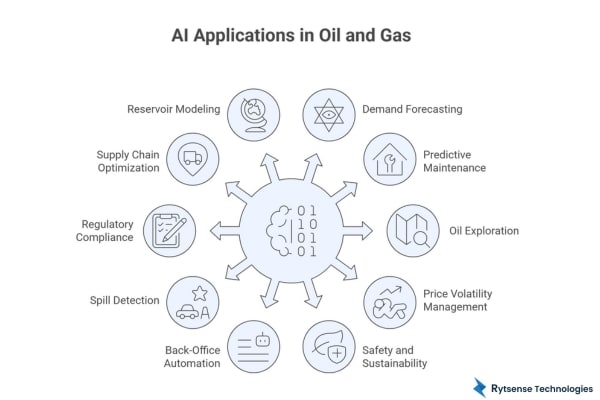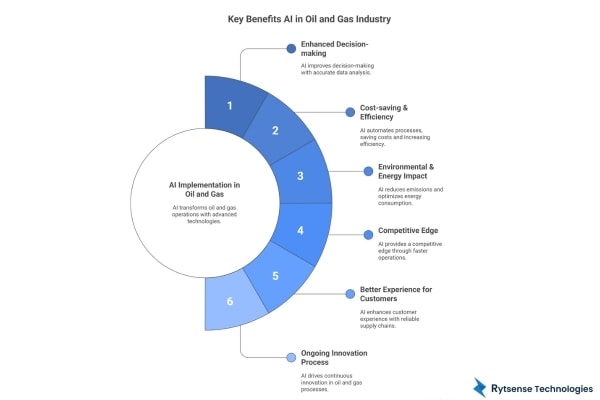-
Key Takeaways
- AI in oil and gas market will reach $4.21 billion by 2028 with 92% companies investing to cut costs by 25%.
- AI reduces unplanned downtime by 30-50% and maintenance costs by 25% through continuous equipment monitoring.
- BP, Shell, and Saudi Aramco achieved 10% efficiency gains and 30% cost reductions using AI technologies.
- Companies save 20-30% operational costs within two years through AI-driven automation and optimization.
- High investment costs ($5-50 million), talent shortage, and data quality issues remain major AI adoption barriers.
AI in Oil and Gas Industry: Real-World Applications, Benefits, and Key Challenges
According to PRN, the global AI in oil and gas market is projected to reach $4.21 billion by 2028 with a CAGR of 10.96%. More than 92% of oil and gas enterprises are investing in AI technologies to improve productivity by at least 25%.
The application of AI in oil and gas industry
AI in Oil and Gas Industry anticipates equipment failures, identifies potential drilling sites safely, and minimizes environmental impact. Qualified engineers and technicians collaborate with AI systems to reduce operational risk. By continuously monitoring live data, AI in oil and gas sector ensures safety, cost containment, and optimized production.
Top AI Use Cases in Oil and Gas Sector

AI in Demand Forecasting
Predictive Maintenance with AI & ML Applications in Oil and Gas Industry
AI in Oil Exploration & Data Analysis
Managing Price Volatility with AI
AI for Safety & Sustainability
RPA and AI in Back-Office Operations
AI for Spill and Hydrocarbon Detection
Generative AI in the Oil and Gas Industry for Regulatory Compliance and Risk Management
AI-Driven Supply Chain Optimization
AI for Reservoir Modeling & Characterization
Real-World Applications of AI in Oil and Gas Industry
BP
Shell
Saudi Aramco
How AI in Oil and Gas Enterprises Improves Efficiency
Data–Driven Decisions
Optimized Extraction and Lower Downtime
Real-time Insights for Smarter Operations
Transform operations with AI-powered insights.
Key Benefits of Advantages of Artificial Intelligence Implementation in Oil and Gas Industry

Enhanced Decision-making
Cost-saving & Efficiency
Environmental & Energy impact
Competitive Edge
Better Experience for Customers
Ongoing innovation process
Challenges in Adopting AI in the Oil and Gas Industry
Resistance to Change
Data Quality Issues
Compliance & Cybersecurity Risks
Cost of Investment
Lack of AI talent
Also Read:
Top AI and ML development companiesEmerging AI Technologies in the Oil and Gas Industry
Machine Learning and Deep Learning
Computer Vision and Remote Monitoring
Digital Twins for Optimization
NLP for Automation
The Future of AI in the Oil and Gas Industry
Intelligent Fields and Autonomous Operations
Sustainability through AI
Predictive Analytics in Energy Transition
Rytsense Technologies: Driving AI Innovation in the oil and gas sector
Conclusion
Even given the challenges of initial implementation, such as cost and talent shortages, the benefits of AI outweigh the challenges. Companies embracing AI will be able to make data-driven decisions and achieve operational excellence, over competitors. As technology continues to evolve, AI will continue to drive sustainable and innovative growth.
Stay ahead in the energy sector with AI-driven innovation.
Meet the Author

Karthikeyan
Co-Founder, Rytsense Technologies
Karthik is the Co-Founder of Rytsense Technologies, where he leads cutting-edge projects at the intersection of Data Science and Generative AI. With nearly a decade of hands-on experience in data-driven innovation, he has helped businesses unlock value from complex data through advanced analytics, machine learning, and AI-powered solutions. Currently, his focus is on building next-generation Generative AI applications that are reshaping the way enterprises operate and scale. When not architecting AI systems, Karthik explores the evolving future of technology,where creativity meets intelligence.